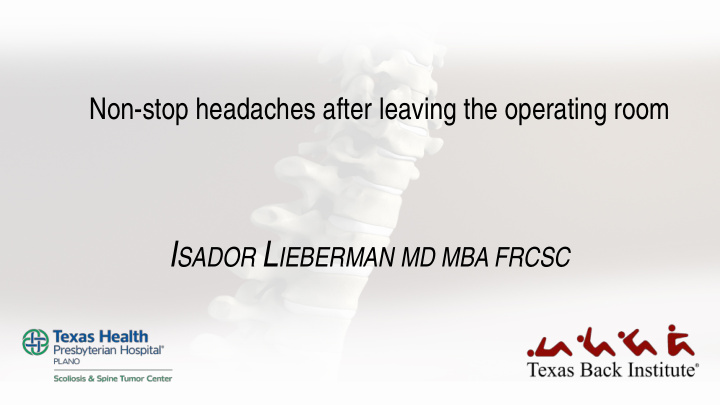



Non-stop headaches after leaving the operating room I SADOR L IEBERMAN MD MBA FRCSC
I SADOR L IEBERMAN MD MBA FRCSC disclosures October 2017 Research Stock Consultant Royalties Support Options Mazor Robotics X X X X X Stryker Spine X Globus Misonix X X Safe Orthopaedics Medtronic X X SI Bone AAOS; member CME Courses committee ISASS; member Public Policy committee SMISS; member Board of Directors Editorial board; Spine, JSD&T, European Spine J
My Headache??? Or the patient’s ???
Dural Tears • Incidence from 2 – 6 % all comers to spine surgery • Revision surgery incidence > 15% • Risk factors = adhesions, ossification, surgeon experience • Strategy 1) Prevention 2) Direct Primary Repair 3) Diversion Drainage
Prevention Ultrasonic Bone Scalpel • Blunt tip blade oscillates at 22.5khz with stroke amplitude of 100 micrometer • Crystalline “non yielding” tissue pulverized • Soft “yielding” tissue displaced • Create osteotomies of .5 mm width up to 20 mm deep • Minimal blood loss & Integrated irrigation/cooling system
Direct Primary Repair • Exposure • Control (suction, protection of nerves) • Watertight Suture Repair (test repair with Valsalva) • Reinforcement (synthetic, allograft, muscle/fascia) • Sealants (fibrin glue, gel preps) • Watertight muscle and skin closure • Diversion subarachnoid drain
Diversion Draining • Subarachnoid drain inserted percutaneously at L2/3 or cervical • Bedrest for 2 – 5 days • Place bag level to drain 200 – 300 ml per day, 5 – 10 ml per hour, • Titrate to headache
Symptoms • Positional headache • Nausea • Photophobia • Clear drainage from incision
Treatments • Analgesics • Antiemetics • Caffiene/Theophylline (to vasoconstrict) • Epidural blood patch
Investigations • Fluid analysis for Beta 2 Transferrin • MRI scan • Radionucleotide cisternography
Thank You I SADOR L IEBERMAN MD MBA FRCSC
Recommend
More recommend